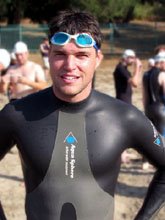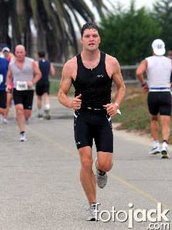I have to admit that I'm pretty abnormal in that a new workout program or idea gets me really excited, especially when it's one that I can incorporate into my own regimen. I certainly like hearing about the latest trends in resistance training for seniors, but it's nothing like when I read an article by a coach I respect who says, "Descending sets have magical properties!" or "Seven sets of four reps will give you the ability to turn invisible!" Heck, I even get excited when some coach I haven't heard of, or actively despise for the dishonor he's visited upon my family, says something weird and off-the-wall about exercise that I think just might work. I can barely wait to get to the gym and put it to work (Disclaimer: the invisible thing doesn't work; I only became slightly translucent).
The one exception has been a training method that's been getting a lot of play during the last few years. It's called total body training, which, as the name suggests, is a method whereby you work all major muscle groups in the course of a single workout session.
This method will strike few people as novel: it's been around since the fifties, and I've used it on clients since I first started training professionally. But the alternative, a "split" system, has always seemed cooler, more advanced, more intense. Total body training seems almost quaint by comparison, partly because it's so simple: go in the gym, work out all your muscles, go home, rest and eat, come back a couple of days later and repeat. In a split system, you divide the body into parts, working some parts one day, some parts another day. An upper-lower split is common; so is what's called a push-pull split, but the possibilities are endless, including what I like to call the "Frankenstein" split, wherein your body is divided into so many sections that you only get around to training the entire thing about once every ten days or so.
The complexity of the split system is what makes it perfect for obsessive exercisers like me: you can fret about the acute variables till you're blue in the face. When I'm planning a new routine for myself, Heidi will often find little scraps of paper strewn about the house with little workout charts and calendars on them, filled in and scratched out as I search obsessively for the better mousetrap of strength-training routines.
But there's really no obsessing with total body training. It's about as straightforward as it gets.
It just seems too easy, I'd think. I'm too advanced for this first-day-of-school stuff. Just six exercises? Just three or four sets each? JUST THREE DAYS A WEEK? What would I do with myself for the other half hour of my daily gym time?
Good old fashioned hubris, folks.
After all the hectoring, all the chat-room talk from the gym rats who have suddenly seen the light, all the disapproving grandmothers at the Y telling me, "You don't need so many sets for your traps, there, son," I decided to give total-body-training a try for, really, the first time since I began working out in the 80s. No more twelve sets for chest, eight for biceps, fifteen for legs. I was going to go by the book, whittling it down to absolute basics.
I decided not to follow any specific coach's system, but basically the workout I devised is a hybrid of the systems of a bunch of guys who are way smarter than I am about this kind of thing, notably Alwyn Cosgrove, Mike Boyle, and Chad Waterbury.I call it my Boylegrovebury routine. I called it the Waterboy-grove routine for awhile but was getting funny looks.
You know where I'm headed here: it works great. It's tough, it's more intense than most split systems I've done, and maybe most useful of all, it's fast. The workouts take about forty minutes, giving me plenty of time to do all those other things in the gym that usually get the short shrift, like dynamic warmups, post-workout stretching and the like. I leave the gym feeling great. Surprisingly, I'm handling weights as heavy as I ever have; recovering well, gaining size in some places, losing it in others as appropriate. It's not just the maintenance routine I expected it would be: I'm making progress, and I'm getting sore.
I wonder if, in a way, all those years of "advanced" training primed the pump for me to return to a lower-volume system. Thanks to all those "chest days" and "leg days," and doing isolation moves till the cows came home, I finally know something about the way my body's put together. I can squat and deadlift with good form, something that I believe took me about ten years to learn to do well. So three working sets is now three real working sets, not two sets of flailing and one set of work. I wonder if it's even possible that that advanced strength trainers in general need LESS volume than intermediates for this very reason.
Presses, chinups, rows, squats, lunges, deadlifts and other basics seem like moves you master with a couple weeks of training. So does the total body training model. The obvious next step seems to be to look for something else, something new, something more advanced. But these moves are really the pliés and straight punches of iron pumping, the things you learn on your first day but will never stop perfecting. When I watch a great athlete in action, it's not so much his ability to call on a thousand obscure techniques and fancy moves that impresses me, nor is that what makes him a good player. It's his mastery of the basics: Tiger's drive, Albert Pujols' swing. Heifetz probably could have made an audience cry playing a G major scale.
Sure, there's a place for advanced techniques in training, but since returning to the oldest of old-school training methods, I'm reminded again that they'll never beat the basics.
PS: I'm going to be offline for a few days -- off to the San Juans for a reunion of my massive Irish-Catholic family till next Monday. In the meantime, check out the various new links to the right of this text! "Greatest Hits of DF," and the video link -- which will be up as a blog entry shortly -- are both free and make great stocking-stuffers!
Tuesday, July 10, 2007
Frankenstein No More!
Subscribe to:
Post Comments (Atom)




3 comments:
Looking forward to hearing how "sick" you'll be about stealing workouts this time! :)
Regarding your comment about more experienced lifters needing less volume: in college I started deadlifting when I had pneumonia and couldn't row. I was doing 5x5 with all the sets being within roughly 20 lbs. of each other, sometimes subbing a triple or double for one or two sets. Within really a year and a half, I couldn't do it anymore and had gone down to 3 sets. Long story short, in between I've read "weightlifting and strength training" by El Hewie and several books by Pavel Tsatsouline and the way they both explain the proper role of total volume to intensity and frequency has been illuminating. Now I do one or two heavy sets only and drop the weights over the next couple of sets until I'm putting in some volume with a weight close to the weight from my highest warmup set. For full body training especially, I've found this effective. Just thought I'd throw in my two cents, since I'm a busy law student who's had to resort to full body workouts because of time constraints.
Hey Joe: Interesting to hear that your experience bears this crazy theory out. I'm not as up on my Pavel as I could be; I must check out Beyond BBing, his seminal text...
Best of luck on studying the law. Harder than 5X5 deadlifts...
Post a Comment